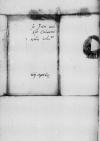⌊Bona⌋ Dei gratia regina ⌊Poloniae⌋, magna dux ⌊Littuaniae⌋, ⌊Russiae⌋, ⌊Prussiae⌋, ⌊Masoviae⌋ etc. domina et heres etc.
Accepimus litteras Paternitatis Tuae, illis quoque inclusas has
, quas i[l]lustris ⌊comes a Nassau⌋ transmisit vertique eas in Latinum curavimus, ex quibus omnia, quae per nos exspectabantur, plane intelleximus. Gratum nobis exstitit, ut quae habemus in hoc negotio quam plures tractatus explicare animum nostrum valeamus et amplecti tandem, quod poti[u]s fore iudicabimus. Tua igitur Paternitas quemadmodum suo Marte hoc negotium proposuit, ita eodem quoque illud absolvat, hac quippe condicione interposita, ut de nobis vel minimum praesumi non possit, quo hoc negotium tractari per nos coeptum sit, nostrae si quidem auctoritati non parum detrahi videretur, confidimus tamen hoc dexteritati Paternitatis Tuae.
Venerabilem ⌊custodem Varmiensem⌋, quem nobis commendat Paternitas Tua, illius virtutis et intercessionis Paternitatis Tuae rationem libenter habebimus faciemusque apud sacram ⌊regiam maiestatem⌋ commendatum illum. Remittimus etiam litteras illas, quas a nobis remitti Paternitas Tua postulavit.
Quae bene valeat.

